

Discover more from Frederick R. Smith Speaks
Beast of the East
Delaware Valley gives testament to rich history and industrial innovation. It has an enduring legacy of the Baldwin Locomotive Works that lives on to this day.
Thus in the very enumeration of our losses by the death of God’s special servants, we see how He answers our prayer and helps us. Help, Lord, or the godly man ceaseth. We are taught that God was in all their lives, and in all that they were permitted to do. Thus we have a strong additional proof that He is in His church, and doing his work. One of the wheels in the divine machine has been removed; but ever since it began to revolve we see that it has been governed by the great Master's hand; and that is just as present now in this last motion by which the instrument has been taken out of our sight, as in all before. The Ruler is revealed by the absence of His servant. We may be in doubt what shall next happen. Whether the good work which the lost servant has done shall be continued, whether another shall take his place; but we have no doubt that God is here, and therein we rest content.
Rev. Daniel S Miller D.D
A sermon on occasion the death of Matthias Baldwin 1866
Words: 2,077 ~ Read time: 9 min
Background
The Delaware Valley encompasses parts of Pennsylvania, New Jersey, Delaware, and Maryland. It boasts a rich tapestry of history, culture, and opportunity. Growing up and living in this region offers a unique and enriching experience.
We cannot overstate the historical importance of the Delaware Valley. This area played a pivotal role in the founding and development of the United States. William Penn founded Pennsylvania in the 17th century as a haven for religious freedom. In 1776, the founders signed the Declaration of Independence in Philadelphia. The Delaware Valley has been at the epicenter of American history. Growing up here provides a firsthand connection to the sites and stories that shaped the nation. That fosters a sense of pride and appreciation for the sacrifices and achievements of those who came before. For my young mind, growing up amidst such cultural richness ignited a lifelong passion for history and creativity.
Moreover, Delaware Valley has a rich history of economic activity and innovation. Major cities like Philadelphia and Wilmington, Delaware are commerce, industry, and technology centers. Residents have access to various career opportunities in these cities.
Following in the footsteps of great individuals like George Washington holds immense importance. Preserving personal growth, societal progress, and historical legacy is essential. George Washington was the first President of the United States. He was a pivotal figure in the American Revolutionary War. His leadership, integrity, and vision continue to inspire generations. Emulating his footsteps offers valuable lessons and insights into leadership. It also guides civic duty and pursuing noble ideals. As detailed later in this essay, it is with honor I can attest to “being in the footsteps” of other great leaders, including Matthias W. Baldwin (1797-1866).
Matthias Baldwin, a jeweler by trade, began experimenting with steam engines in the 1820s. He recognized steam power’s potential in transportation. He founded the Baldwin Locomotive Works in Philadelphia, Pennsylvania. In 1832, the company completed its first locomotive, “Old Ironsides.” The Philadelphia, Germantown, and Norristown Railroad had it built. That marked the beginning of Baldwin’s legacy in locomotive manufacturing.
Among Baldwin’s philanthropies was education for black children. His abolitionist sympathies led to a Southern boycott of his engines shortly before the American Civil War. Sadly, during the inane riots of 2020, miseducated-ignorant hoodlums vandalized the statue of Baldwin.
Baldwin Locomotive Works
The Baldwin Locomotive Works holds a significant place in the history of industrial America and the world. In particular, it led to the development and proliferation of steam locomotives. Matthias W. Baldwin founded Baldwin Locomotive Works in 1831. It became one of the most prominent locomotive manufacturers in the United States during the 19th and early 20th centuries.
Throughout the 19th century, Baldwin Locomotive Works was pivotal in expanding railroads. Railroad companies sought Baldwin locomotives. The company’s innovative designs and efficient production methods made it famous. Baldwin’s early locomotives gained renown for their reliability and performance. They earned a reputation as some of the finest steam locomotives in the world.
As the demand for locomotives grew, Baldwin expanded its operations. They constructed more extensive manufacturing facilities and employed thousands of workers. The company’s workforce included skilled artisans such as machinists, engineers, and blacksmiths. They crafted each locomotive by hand.
Baldwin’s success was more expansive than the domestic market. The company also exported locomotives to countries worldwide. That contributed to the global spread of railway technology. Baldwin locomotives operated in Europe, South America, Asia, and beyond. That further solidified the company’s reputation as an industry leader.
In 1928, the company opened a new plant near Eddystone, Pennsylvania, south of Philadelphia. The designers created this state-of-the-art facility to streamline production processes and increase efficiency. The Eddystone plant became Baldwin’s primary manufacturing center. The latest technologies and machinery equipped it. It continued the legacy of locomotive production, albeit on a smaller scale than its predecessor. The plant focused on building specialized locomotives for various industries. These included mining, logging, and industrial applications. In 1937, the Philadelphia plant ceased locomotive production, marking the end of an era for Baldwin in its historic birthplace.
The early 20th century saw significant changes to the railroad industry. That included the rise of diesel-electric locomotives and the decline of steam power. In 1939, Baldwin produced diesel locomotives alongside its traditional steam models. But, the transition took time, and Baldwin faced stiff competition from other manufacturers.
During World War II, the Eddystone plant was crucial in supporting the war effort by producing steam locomotives for military use. Yet, the decline in demand for steam locomotives after the war brought similar challenges. The rise of diesel-electric technology also led to challenges. Baldwin attempted to diversify its product line. It manufactured items such as trolley buses and heavy machinery. Yet, it needed more to sustain operations. Still, the steam locomotive remained Baldwin’s primary focus for much of its existence.
In 1950, Baldwin merged with Lima-Hamilton. That was in response to declining sales and diminishing market presence. Lima Locomotive Works, located in Lima, Ohio, was once among the top three steam locomotive manufacturers. But it had overlooked the diesel market. Lima Locomotive Works entered the diesel market in 1947, merging with engine builder Hamilton. Unfortunately, the combined Lima-Hamilton did not introduce a production-model diesel-electric locomotive until 1949. By that time, they deemed it too little, too late. The company produced a total of 174 diesel locomotives. Most of these units were switchers. In 1951, they discontinued the line in favor of Baldwin’s designs.
Despite efforts to modernize, Baldwin-Lima-Hamilton (BLH) struggled to maintain its market share. That was due to stiff competition and changing technologies. The company faced financial difficulties and labor strikes to face decline. Baldwin produced over 70,500 locomotives in 125 years of continuous production. In 1956, the year of my birth, BLH ceased locomotive production altogether, marking the end of an era. It continued as a parts supplier and closed permanently in 1972.
Today, people cherish Baldwin’s locomotives as relics of a bygone era. Museums preserve many, and heritage railways operate many.1 The legacy of Baldwin Locomotive Works lives on through these historic machines. They serve as a testament to the ingenuity and craftsmanship of America’s early industrial pioneers.
Baldwin’s Spirit Lives On
Beast of the East
Western Maryland Scenic Railroad 1309 is a compound articulated “H-6” “Mallet” type steam locomotive. It has a 2-6-6-2 (Whyte System) wheel arrangement.2 The Baldwin Locomotive Works crafted this locomotive as their final reciprocating steam-powered masterpiece in 1949.3 It served the Chesapeake and Ohio Railway (C&O). It hauled coal trains until its retirement in 1956. That was the same year BLH ceased locomotive building operations and the birth of your author. Following its illustrious career, No. 1309 found a home at the B&O Railroad Museum in 1972, where it stood as a static display until 2014. The Western Maryland Scenic Railroad (WMSR) acquired the locomotive in a remarkable turn of events. That ignited a comprehensive restoration program spanning several years. The arduous efforts culminated in a triumphant moment on December 31, 2020. The locomotive emerged revitalized and ready for service. Finally, on December 17, 2021, it embarked on its maiden voyage in tourist excursion service for the WMSR, marking a significant milestone. It was the first articulated locomotive to grace the Eastern United States. Norfolk and Western 1218 retired in November 1991.
Dubbed as the “Beast of the East,” 1309 rivals the largest steam locomotive ever built, Union Pacific’s “Big Boy.” The Union Pacific Big Boy locomotive is a testament to engineering ingenuity and industrial prowess. The American Locomotive Company (ALCO) crafted the order of locomotives from 1941 to 1944. The Union Pacific Railroad operated these imposing machines until 1962. They had a unique 4-8-8-4-wheel arrangement. It featured four-wheel leading and trailing trucks, with two sets of eight driving wheels sandwiched between them. This configuration provided stability on curves. It also offered ample support for the locomotive’s sizable firebox.
Today, the legacy of the Big Boy endures through the preservation of eight surviving examples. Many of them grace the static displays of museums throughout the United States. Locomotive No. 4014 found its way back into the hands of Union Pacific, embarking on a remarkable restoration journey between 2014 and 2019. As a result, No. 4014 has reclaimed its status as the largest and most potent operational steam locomotive globally. It symbolizes a triumph of heritage preservation and a living tribute to the bygone era of steam locomotion.
Baldwin Tower
Today, people know the Baldwin Locomotive Works office building as the Baldwin Tower office building. One of America’s most iconic industrial giants has an intertwined and storied history with its rise and decline.
The architectural firm of Frank Furness and George Hewitt designed the office building. It is a testament to the era’s industrial might and architectural prowess. The building’s distinctive blend of Romanesque and Gothic architectural styles characterized it. It exuded an aura of strength and permanence, befitting its role as the nerve center of Baldwin’s operations. An office management company that now owns Baldwin Tower and houses several companies under a lease arrangement. In an ironic twist of fate, I worked at an office in the Baldwin Tower from 2006 until my retirement in 2018. That time is the capstone of my 45-year railroad career. It is an honor and privilege to have worked in the building where engineers designed the Beast of the East.
Daring Diesels Alive Today
SMS Rail Lines is a short-line railroad headquartered in the Pureland Industrial Complex in Bridgeport, New Jersey. The company’s primary focus is delivering freight cars to businesses in the industrial park. They serve as a vital link in their supply chain logistics. SMS also operates industrial lines in Westville, New Jersey, Morrisville, Pennsylvania, and three locations in New York: Albany, Waterford, and Fort Edward. More recently, it resurrected a dormant line in Woodstown, New Jersey, offering tourist train rides.
SMS Rail Lines has preserved locomotives made by the esteemed Baldwin Locomotive Works. They continue using them. That showcases a dedication to heritage and operational efficiency. The SMS corporate headquarters and locomote shop are across the Delaware River, five miles from the Baldwin Tower. Few Baldwin diesel locomotives remain operational in the world. Thus, with six units on its roster, SMS can proclaim its unique position as the largest user of Baldin units in the world today.
Conclusion
In conclusion, Delaware Valley is a testament to its rich history, industrial innovation, and enduring legacy intertwining. From its pivotal role in founding the United States to the illustrious heritage of the Baldwin Locomotive Works, this region encapsulates a tapestry of cultural significance and economic dynamism. Baldwin’s rise, adaptation, and eventual decline mirrors the broader narrative of industrial evolution and the challenges of technological progress. Yet, amidst this evolution, the spirit of Baldwin lives on, echoed in the resounding chug of locomotives like the “Beast of the East” and the operational prowess of SMS Rail Lines. As we reflect on the past and embrace the future, let us cherish the Delaware Valley’s legacy and its pioneers’ enduring impact on our fond journey forward. 📕
Sources
Baldwin Locomtove Works Historical Marker, ExplorePAhistory.com. Also, the source of the locomotive works photographs.
The Locomotives Baldwin Built ~ Fred Westing ~192 pages ~ Bonanza Books, 1966
Guide to North American Diesel Locomotives ~ Jeff Wilson ~ 303 pages, Kalmbach Books ~ 2017
Guide to North America Steam Locomotives ~ George H. Drury ~ 335 pages ~ Kalmbach Books ~ 2015
Memorial Matthias W. Baldwin ~ Privately printed 1867
Lima-Hamilton Locomotives: Diesels that didn’t ~ Classic Trains September 26, 2021
I warmly encourage you to consider becoming a paid subscriber if you have the means. Tips are appreciated, too. Regardless of your choice, your support is deeply appreciated. From the bottom of my heart, thank you for your invaluable support!
Click here for a list of all operating locomotives of all builders in the United States.
See Frederick R. Smith’s essay 1918 Railroads Railroaded for an explanation of the “The Whyte System.”
In 1954, BLH built a stem turbine locomotive called the Jawn Henry for Norfolk Western.





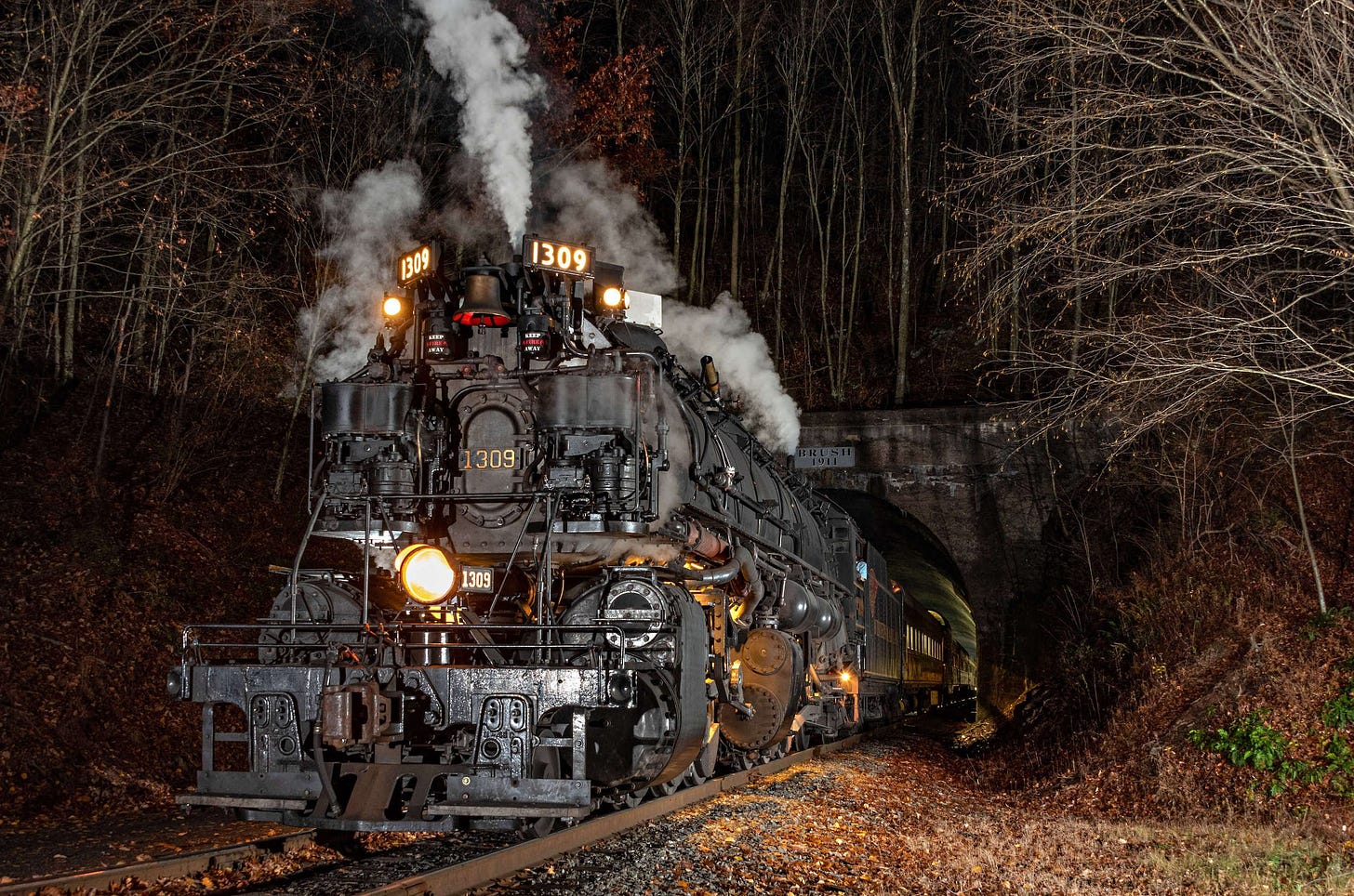

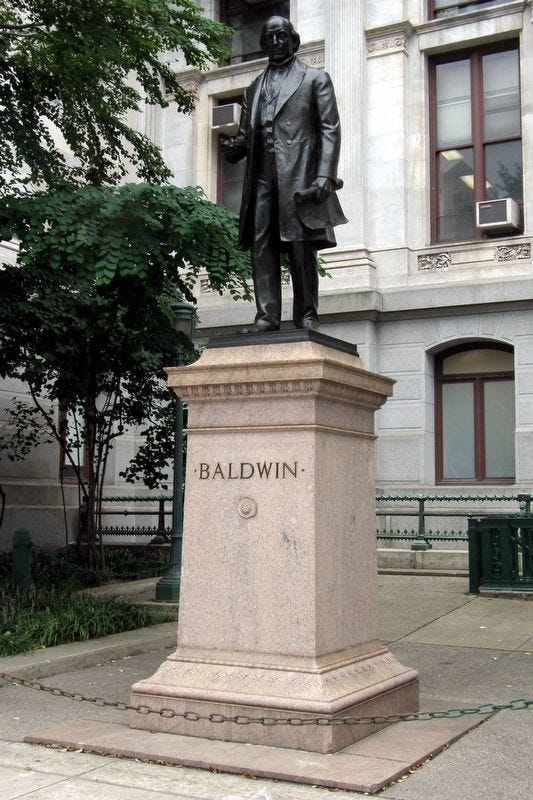
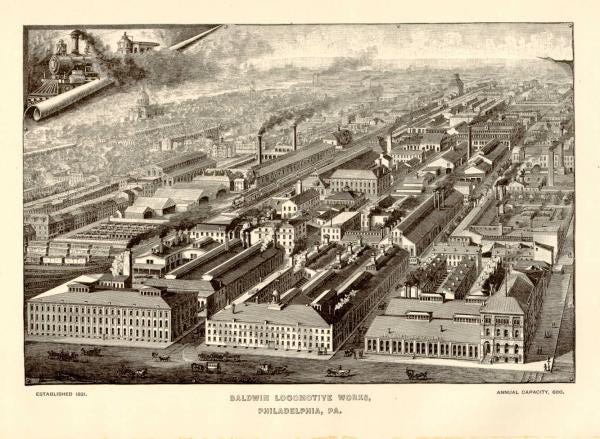
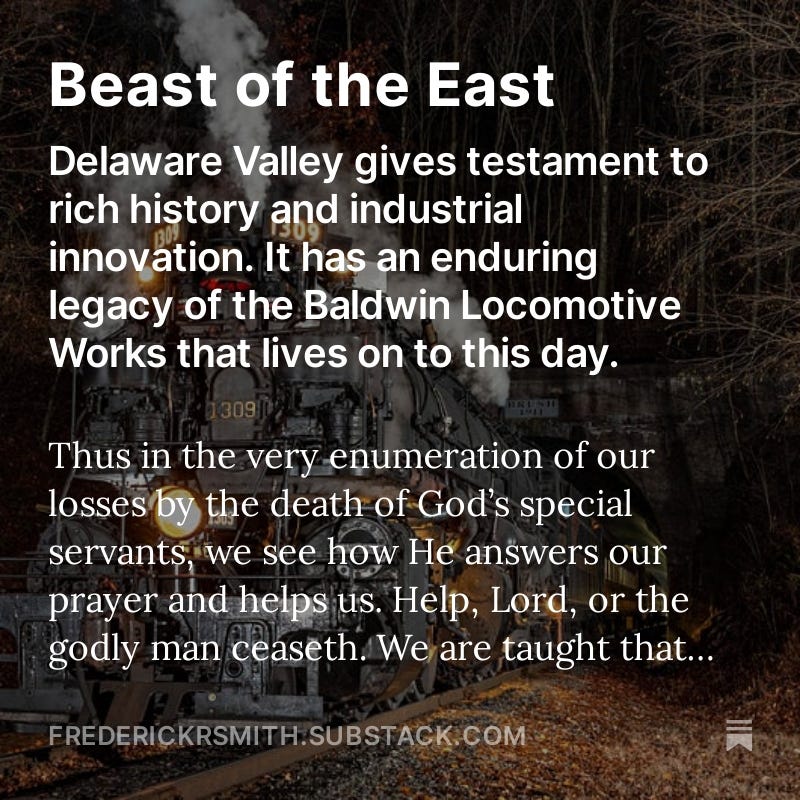
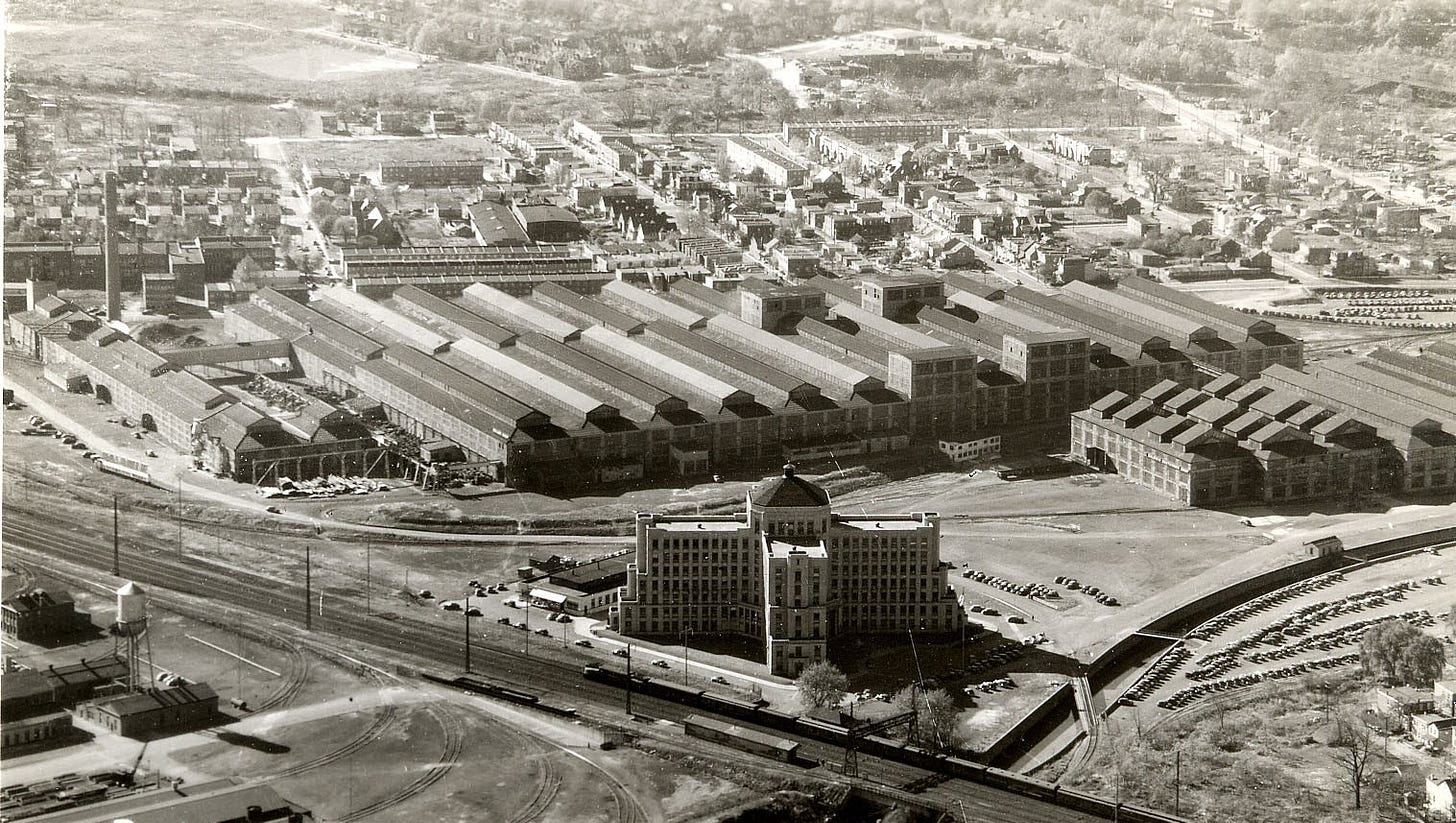
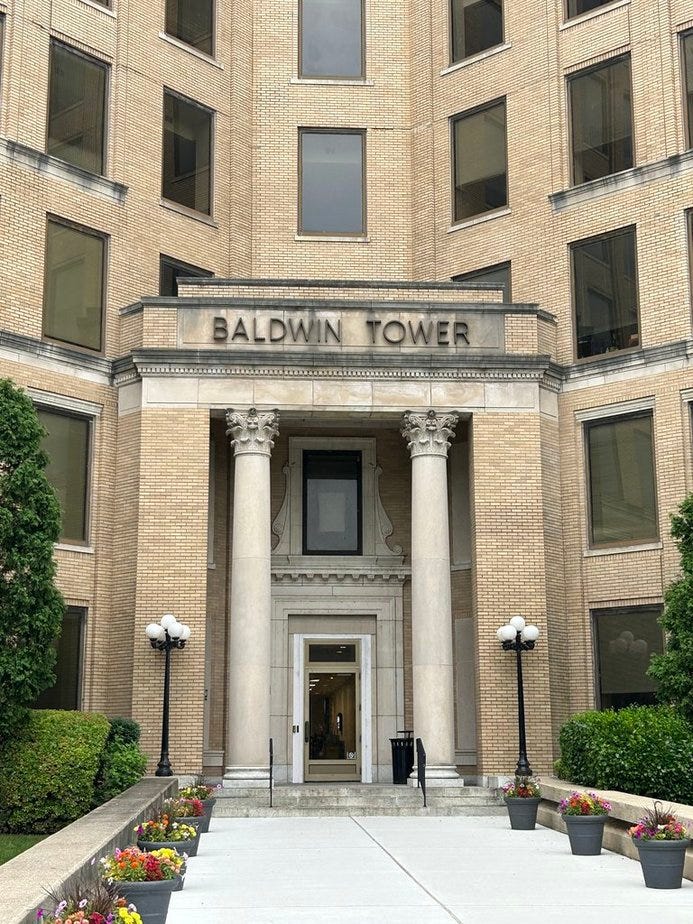
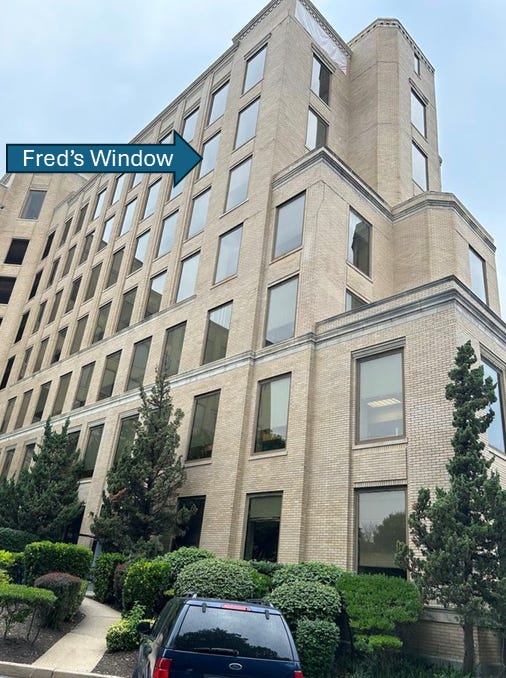
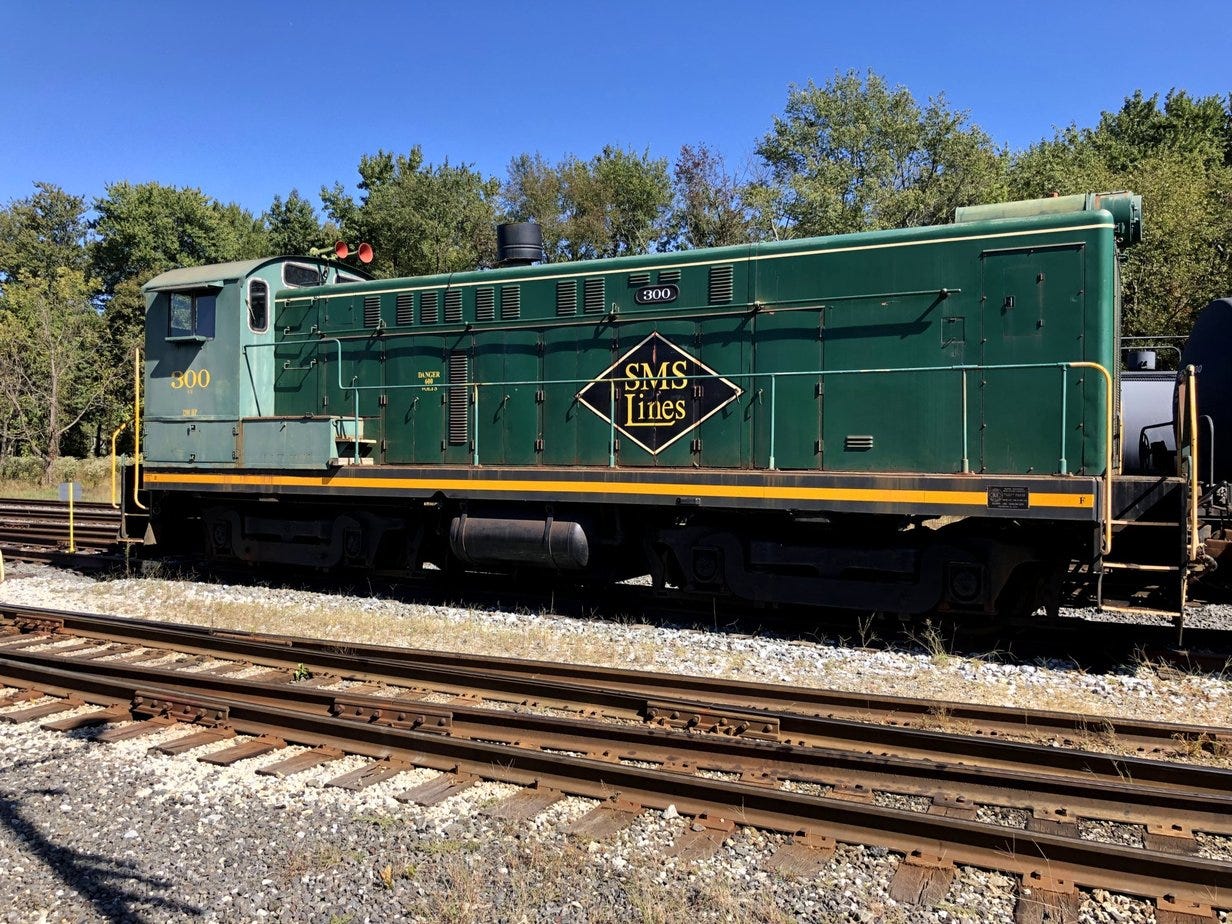








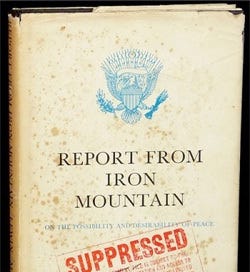



I was in the Baldwin Tower during the 2011 earthquake. The building swayed and I evacuated and went home. https://www.cbsnews.com/philadelphia/news/5-8-earthquake-rattle-east-coast/
I hesitate to respond for fear of not being able to do justice to what you’ve written nor being able to sufficiently set down my own feelings after having read your history of Baldwin Locomotive works and the Delaware Valley and, by extension, the City of Philadelphia.
I am obsessing on the sermon and its simple meaning that in the absence of a person with his lived accomplishments (no matter how grand or humble) you shall know God. I spent 10 years of my life in the early 1970’s researching the liens and indentures of the various railroads of the Delaware and adjacent valleys and could not take my mind off the people who built and maintained this complex structure that allowed the rest of us to thrive and prosper. Who installed the interlocking on the East Pennsylvania RR at its connection with the B&O? Is the Reading track to Bound Brook, NJ capable of hauling fast freight? Who pounded the rail onto the ties? Whose eye pronounced the installation plumb and true? The absence of all these people today has left an unseen magnificent symphony of accomplishment and history that can only be attributed to the existence of “g